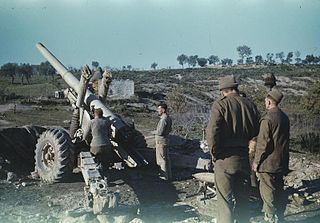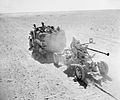
Self-propelled artillery is artillery equipped with its own propulsion system to move towards its firing position. Within the terminology are the self-propelled gun, self-propelled howitzer, self-propelled mortar, and rocket artillery. They are high mobility vehicles, usually based on continuous tracks carrying either a large field gun, howitzer, mortar, or some form of rocket/missile launcher. They are usually used for long-range indirect bombardment support on the battlefield.

The 25pdr SP, tracked, Sexton was a Canadian-designed self-propelled artillery vehicle of the Second World War. It was based on Canadian-built derivatives of the American M3 Lee and M4 Sherman tank chassis. Canada had set up to produce the Ram tank using the M3 chassis and Grizzly to complement US medium tank production; when Sherman production in the US expanded and supply was no longer a problem, it was decided in 1943 to switch the Canadian production lines to produce the Sexton to give the British Army a mobile artillery gun using their 87.6 mm (3.45 in) Ordnance QF 25 pounder gun-howitzer for commonality with towed guns. The Sexton could fire either HE shell or an armour-piercing shell. It found use in the Canadian and British Army, as well as numerous other British Empire and associated forces. Just after the war, a number of Grizzly and Sextons were sold to Portugal, who used them into the 1980s.

The Ordnance Quick-Firing 17-pounder was a 76.2 mm (3 inch) gun developed by the United Kingdom during World War II. It was used as an anti-tank gun on its own carriage, as well as equipping a number of British tanks. Used with the APDS shot, it was capable of defeating all but the thickest armour on German tanks. It was used to 'up-gun' some foreign-built vehicles in British service, notably to produce the Sherman Firefly variant of the US M4 Sherman tank, giving British tank units the ability to hold their own against their German counterparts. In the anti-tank role, it was replaced after the war by the 120 mm BAT recoilless rifle. As a tank gun, it was succeeded by the 84 mm 20 pounder.

The Ordnance QF 25-pounder, or more simply 25-pounder or 25-pdr, was the major British field gun and howitzer during the Second World War. Its calibre is 3.45-inch (87.6 mm). It was introduced into service just before the war started, combining both high-angle and direct-fire abilities, a relatively high rate of fire, and a reasonably lethal shell in a highly mobile piece. It remained the British Army's primary artillery field piece well into the 1960s, with smaller numbers serving in training units until the 1980s. Many Commonwealth of Nations countries used theirs in active or reserve service until about the 1970s and ammunition for the weapon is currently being produced by Pakistan Ordnance Factories. Initial production was slow, but by 1945, over 12,000 had been manufactured. The 25-pounder was probably the most outstanding field artillery piece used by British and Commonwealth forces in the Second World War, being durable, easy to operate and versatile.

The Universal Carrier, also known as the Bren Gun Carrier and sometimes simply the Bren Carrier from the light machine gun armament, is a common name describing a family of light armoured tracked vehicles built by Vickers-Armstrongs and other companies.
A limber is a two-wheeled cart designed to support the trail of an artillery piece, or the stock of a field carriage such as a caisson or traveling forge, allowing it to be towed. The trail is the hinder end of the stock of a gun-carriage, which rests or slides on the ground when the carriage is unlimbered.

The M10 tank destroyer was an American tank destroyer of World War II. After US entry into World War II and the formation of the Tank Destroyer Force, a suitable vehicle was needed to equip the new battalions. By November 1941, the Army requested a vehicle with a gun in a fully rotating turret after other interim models were criticized for being too poorly designed. The prototype of the M10 was conceived in early 1942 and delivered in April that year. After appropriate changes to the hull and turret were made, the modified version was selected for production in June 1942 as the 3-inch Gun Motor Carriage M10. It mounted a 3-inch gun M7 in a rotating turret on a modified M4 Sherman tank chassis. An alternate model, the M10A1, which used the M4A3 variant chassis, was also produced. Production of the two models ran from September 1942 to December 1943 and October 1942 to November 1943, respectively.

The Ordnance Quick-Firing 6-pounder 7 cwt, or just 6-pounder, was a British 57 mm gun, serving during the Second World War as a primary anti-tank gun of both the British and United States Army. It was also used as the main armament for a number of armoured fighting vehicles.

The Ordnance QF 2-pounder, or simply "2 pounder gun", was a 40 mm (1.575 in) British anti-tank gun and vehicle-mounted gun employed in the Second World War.

The BL 5.5-inch gun was a British artillery gun introduced during the middle of the Second World War to equip medium batteries.

The Morris Commercial C8 FAT, commonly known as a Quad, is an artillery tractor used by the British and Commonwealth forces during the Second World War. It was used to tow field artillery pieces, such as the 25-pounder gun-howitzer, and anti-tank guns, such as the 17-pounder.

The L118 light gun is a 105 mm towed howitzer. It was originally produced for the British Army in the 1970s and has been widely exported since, including to the United States, where a modified version is known as the "M119 howitzer".

An artillery tractor, also referred to as a gun tractor, is a specialized heavy-duty form of tractor unit used to tow artillery pieces of varying weights and calibres. It may be wheeled, tracked, or half-tracked.

The Sd.Kfz. 7 was a half-track military vehicle used by the German Wehrmacht Heer, Luftwaffe and Waffen-SS during the Second World War. Sd.Kfz. is an abbreviation of the German word Sonderkraftfahrzeug, "special purpose vehicle". A longer designation is Sd.Kfz. 7 mittlerer Zugkraftwagen 8t, "medium towing motor vehicle 8t".

The Ordnance QF 13-pounder (quick-firing) field gun was the standard equipment of the British and Canadian Royal Horse Artillery at the outbreak of World War I.

The Scammell Pioneer was a British 6×4 tractor unit used in World War II as an artillery tractor, recovery vehicle and tank transporter.

The CMP FAT, was a Canadian Military Pattern vehicle manufactured by Ford and Chevrolet. The FAT was an artillery tractor of the British and Commonwealth forces during World War II. Several models were produced by the two manufactures as CGT and FGT.

The Ordnance QF 25-pounder Short was an Australian variant of the British Ordnance QF 25-pounder field gun/howitzer. The gun was developed by modifying the 25-pounder's design to improve its mobility during jungle warfare. Development began in 1942, and the weapon first entered service with the Australian Army the next year. It was used by several Royal Australian Artillery regiments during fighting in the South West Pacific Area, before being declared obsolete in 1946.
The Vickers Medium Dragon was a fully-tracked British field artillery tractor made by Vickers, produced in various versions from 1922 to 1937. It was developed from the carrier version of a 'Tropical Tank' designed by Lt-Colonel Philip Johnson, using components from the running gear of the Vickers Medium Mark I tank. The Mark IV version of the Medium Dragon was effectively a complete re-design, using the running gear from the Vickers 6-ton tank which was not adopted by the British Army. The Army finally decided in 1935 to purchase only wheeled artillery tractors, and no more were sold in the UK, but the Medium Dragon Mark IV sold well in export versions up to 1937. The Medium Dragons towed a wide range of artillery, from 18-pounder field guns to BL 60-pounder heavy field guns.





















